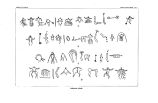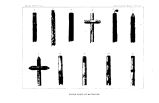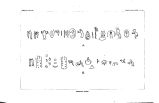| OCR Text |
Show XXIV ANNUAL REPORT OF THE DIRECTOR upon the summit of the mesas; that there came a time when they were at war with the Apaches and Navajos, when they abandoned their stone pueblos above and for greater protection excavated the chambers in the cliffs below; that when this war ended part of them returned to the pueblos above, which were rebuilt; that there afterward came another war, with the Comanche Indians, and they once more resorted to cliff dwellings. At the close of this war they built a pueblo in the valley of the Rio Grande, but at the time of the invasion of the Spaniards their people refused to be baptized, and a Spanish army was sent against them, when they abandoned the valley below and once more inhabited the cliff dwellings above. Here they lived many years, until at last a wise and good priest brought them peace, and persuaded them to build the pueblo which they now occupy- the village of Santa Clara. The ruin of the pueblo which they occupied previous to the invasion of the Spaniards is still to be seen about a mile distant from the present pueblo. The history thus briefly given was repeated by the governor and by other persons, all substantially to the same effect. It is therefore evident that the cavate dwellings of the Santa Clara region belong to a people still extant; that they are not of great antiquity, and do not give evidence of a prehistoric and now extinct race. Plans and measurements were made of some of the villages with sufficient accuracy to prepare models. Photographic views and sketches were also procured with which to illustrate a detailed report of the subject to be published by the Bureau. WORK OF MR. JAMES STEVENSON. After the investigations made in company with the Director, as mentioned above, Mr. Stevenson proceeded with a party to the ancient province of Tusayan, in Arizona, to study the characteristics of the Moki tribes, its inhabitants, and to make collections of such implements and utensils as illustrate their arts and industries. Several months were spent among the villages, resulting in a large collection of rare objects, all of which were selected with special reference to their anthro- |














































































































































































































































































































































































































